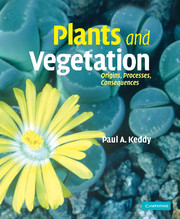Book contents
- Frontmatter
- Contents
- Preface
- Acknowledgements
- Chapter 1 Plants and the origin of the biosphere
- Chapter 2 Description of vegetation: the search for global patterns
- Chapter 3 Resources
- Chapter 4 Stress
- Chapter 5 Competition
- Chapter 6 Disturbance
- Chapter 7 Herbivory
- Chapter 8 Positive interactions: mutualism, commensalism, and symbiosis
- Chapter 9 Time
- Chapter 10 Gradients and plant communities: description at local scales
- Chapter 11 Diversity
- Chapter 12 Conservation and management
- Questions for Review
- References
- Index
- References
Chapter 11 - Diversity
- Frontmatter
- Contents
- Preface
- Acknowledgements
- Chapter 1 Plants and the origin of the biosphere
- Chapter 2 Description of vegetation: the search for global patterns
- Chapter 3 Resources
- Chapter 4 Stress
- Chapter 5 Competition
- Chapter 6 Disturbance
- Chapter 7 Herbivory
- Chapter 8 Positive interactions: mutualism, commensalism, and symbiosis
- Chapter 9 Time
- Chapter 10 Gradients and plant communities: description at local scales
- Chapter 11 Diversity
- Chapter 12 Conservation and management
- Questions for Review
- References
- Index
- References
Summary
Three main patterns: area, habitat variation, latitude. Some evolutionary considerations. Some examples of diversity: Mediterranean climates, carnivorous plants, deciduous forests, endemic species. Four models describing diversity at smaller scales: intermediate biomass, competitive hierarchies, intermediate disturbance/gap dynamics, centrifugal organization. Relative abundance patterns. Evenness and diversity. Laboratory experiments. Field experiments. Conservation.
Introduction
How many kinds of plants are there altogether? And why do some areas of the world have more plant species than others? In some textbooks and reviews, students new to these questions are referred to articles such as Hutchinson (1959) and May (1988) – both of which conspicuously ignore plants! In his essay entitled “Homage to Santa Rosalia” Hutchinson (1959) wrote “[W]hy are there so many kinds of plants? As a zoologist I do not want to ask that question directly, I want to stick with animals but also get the answer.” May (1988) makes one single statement (without a reference) on plant diversity and then moves on to animal diversity! Yet, plants constitute over one-quarter of a million species (Groombridge 1992) and over 99 percent of the Earth's biomass (Whittaker 1975), while the number of species of fungi has been estimated at 1.65 million (Hawksworth 1990).
In this chapter we will explore the factors that allow so many different species of plants to occur and to coexist. The approach emphasizes two questions:
What environmental factors are correlated with plant diversity at specified scales?
What methods have provided evidence about the nature and causes of these patterns?
- Type
- Chapter
- Information
- Plants and VegetationOrigins, Processes, Consequences, pp. 502 - 548Publisher: Cambridge University PressPrint publication year: 2007



